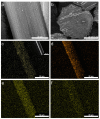Ratiometric Upconversion Temperature Sensor Based on Cellulose Fibers Modified with Yttrium Fluoride Nanoparticles
- PMID: 35683781
- PMCID: PMC9182498
- DOI: 10.3390/nano12111926
Ratiometric Upconversion Temperature Sensor Based on Cellulose Fibers Modified with Yttrium Fluoride Nanoparticles
Abstract
In this study, an optical thermometer based on regenerated cellulose fibers modified with YF3: 20% Yb3+, 2% Er3+ nanoparticles was developed. The presented sensor was fabricated by introducing YF3 nanoparticles into cellulose fibers during their formation by the so-called Lyocell process using N-methylmorpholine N-oxide as a direct solvent of cellulose. Under near-infrared excitation, the applied nanoparticles exhibited thermosensitive upconversion emission, which originated from the thermally coupled levels of Er3+ ions. The combination of cellulose fibers with upconversion nanoparticles resulted in a flexible thermometer that is resistant to environmental and electromagnetic interferences and allows precise and repeatable temperature measurements in the range of 298-362 K. The obtained fibers were used to produce a fabric that was successfully applied to determine human skin temperature, demonstrating its application potential in the field of wearable health monitoring devices and providing a promising alternative to thermometers based on conductive materials that are sensitive to electromagnetic fields.
Keywords: lanthanide ions; multifunctional cellulose fibers; ratiometric temperature sensor; wearable sensor.
Conflict of interest statement
The authors declare no conflict of interest.
Figures





References
-
- Amin A.S. Application of a Triacetylcellulose Membrane with Immobilizated of 5-(2′,4′-Dimethylphenylazo)-6-Hydroxypyrimidine-2,4-Dione for Mercury Determination in Real Samples. Sens. Actuators B Chem. 2015;221:1342–1347. doi: 10.1016/j.snb.2015.07.106. - DOI
-
- Jiang X., Xia J., Luo X. Simple, Rapid, and Highly Sensitive Colorimetric Sensor Strips from a Porous Cellulose Membrane Stained with Victoria Blue B for Efficient Detection of Trace Cd(II) in Water. ACS Sustain. Chem. Eng. 2020;8:5184–5191. doi: 10.1021/acssuschemeng.9b07614. - DOI
-
- Li N., Yin J., Wei L., Shen Q., Tian W., Li J., Chen Y., Jin J., Teng H., Zhou J. Facile Synthesis of Cellulose Acetate Ultrafiltration Membrane with Stimuli-Responsiveness to PH and Temperature Using the Additive of F127-b-PDMAEMA. Chin. J. Chem. 2017;35:1109–1116. doi: 10.1002/cjoc.201600820. - DOI
-
- Mahadeva S.K., Yun S., Kim J. Flexible Humidity and Temperature Sensor Based on Cellulose–Polypyrrole Nanocomposite. Sens. Actuators A Phys. 2011;165:194–199. doi: 10.1016/j.sna.2010.10.018. - DOI
-
- Manjakkal L., Franco F.F., Pullanchiyodan A., González-Jiménez M., Dahiya R. Natural Jute Fibre-Based Supercapacitors and Sensors for Eco-Friendly Energy Autonomous Systems. Adv. Sustain. Syst. 2021;5:2000286. doi: 10.1002/adsu.202000286. - DOI
Grants and funding
LinkOut - more resources
Full Text Sources

